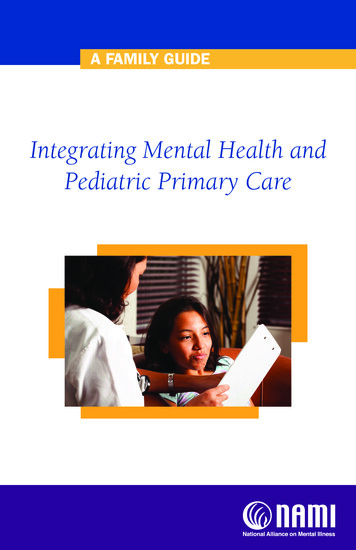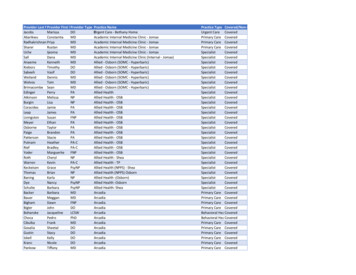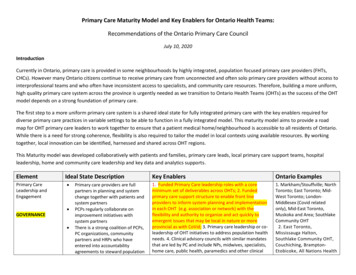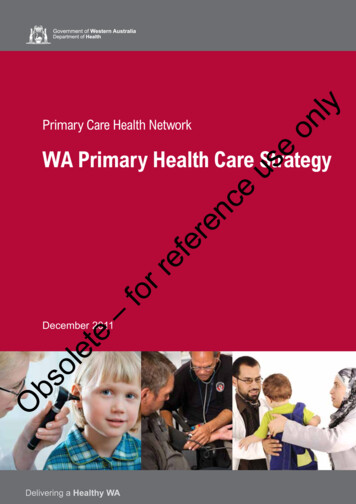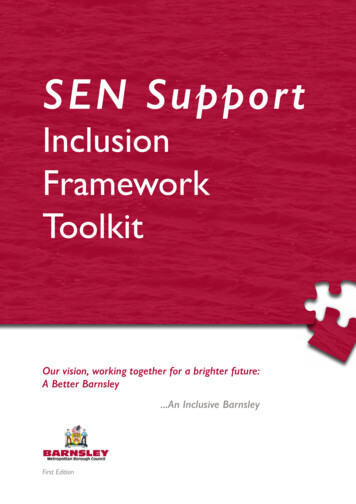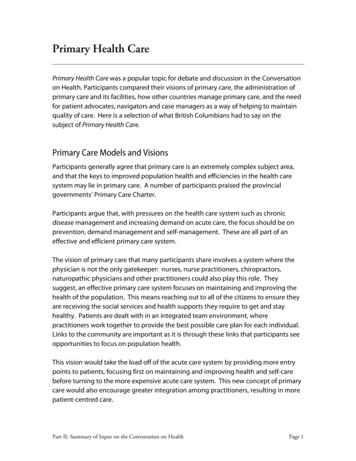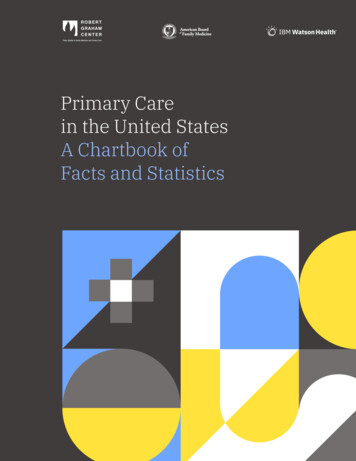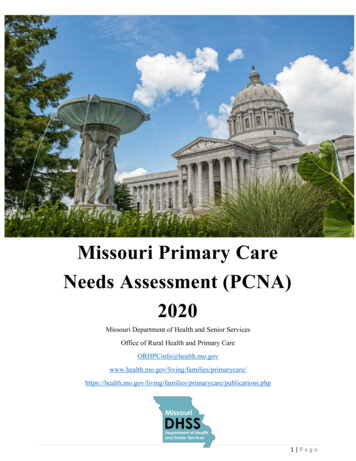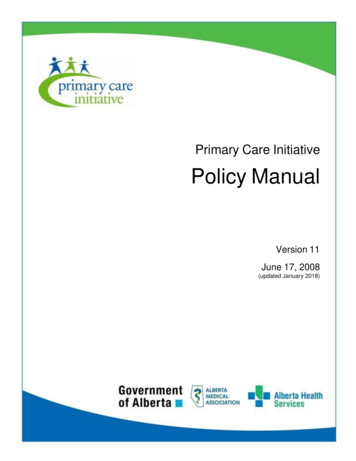
Transcription
Primary Care InitiativePolicy ManualVersion 11June 17, 2008(updated January 2018)
Table of Contents1. Introduction. 12. PCN Objectives (revised April 2017) . 23. PCIC Principles for PCN Development . 34. Service Responsibilities . 44.1Service Responsibility Policy . 54.2Service Responsibility Definitions . 55. Letters of Intent . 66. Business Plan . 66.1Business Plan Parameters. 66.2Business Plan Principles . 67. Enrolment . 107.1General Enrolment Policy . 107.2Informal Enrolment Policy . 107.3Formal Enrolment Policy . 118. Encounters . 128.1Definition of Encounter . 128.2Encounters Objectives . 128.3Encounters Policy . 129. Payments. 159.1Payment Policy . 159.2Grants, Donations and Gifts Policy (new April 2016) . 1510. Business Plan Development Funding . 1610.1Purpose . 1610.2Business Plan Development Funding Process . 1611. Per-Capita Funding . 1811.1General Per-Capita Funding Policy . 1811.2Reimbursement Principles . 1911.3Reimbursement Components . 1911.4Physician Reimbursement Policy. 1911.5RHA Reimbursement Policy . 2511.6Capital Expense Policy (revised April 2017) . 2511.7Transition Policy . 2911.8Internal Financial Controls Policy (new April 2017) . 3011.9Investment Policy (new January 2010) . 33
11.10 Purchasing Policy (new January 2010). 4011.11 Community Member Compensation/Reimbursement Policy (new April 2016) 4211.12 Operational Stability Fund Policy (new April 2018) . 4312. Capacity-Building Grant Funding . 4412.1Capacity-Building Grant Policy . 4413. Specialist Linkages Funding . 4513.1Specialist Linkages Policy . 4513.2Amount of Specialist Linkages Funding . 4613.3Specialist Linkages Activities . 4613.4Specialist Linkages Funding Guidelines for Travel . 4714. Network Accountability . 4814.1Monitoring and Reporting. 4814.2Business Plan Amendments . 4914.3Support for Meeting Primary Care Network Responsibilities. 5014.4Resolving PCI-Primary Care Network Differences . 5214.5Closure Policy (new October 2016). 5214.6PCN Board Governance Policy (new April 2017) . 5514.7Zone Primary Care Network Participation Policy (new December 2017) . 5815. Appendix A – Service Responsibility Definitions . 6016. Appendix B - Definition of Primary Care Network Provider. 6616.1Primary Care Network Provider Types . 66116.2Primary Care Network Provider Roles . 6616.3Primary Care Network Provider Role Combinations . 6816.4Determining Whether Providers are Core or Associate . 6816.5Scenarios. 6817. Appendix C - Definition of Enrolment. 6917.1Enrolment Type . 6917.2Enrolment Lists . 6918. Appendix D - Definition of Service Delivery Location . 7018.1Definition. 7018.2Registered Facilities . 7018.3Other Locations . 7119. Appendix E - Definition of Encounter . 7219.1Background . 7219.2Definition. 7219.3Services Not Counted as Primary Care Network Encounters . 7419.4Encounters Applied to Determination of Per Capita Payments . 74
1.IntroductionThe Primary Care Initiative (PCI) Policy Manual was developed by the Primary Care InitiativeCommittee (PCIC) to provide the foundation on which Primary Care Networks will bedeveloped, implemented and evaluated. Policy and principles will be developed for thosecomponents where provincial direction is required to ensure that PCI objectives are achieved. Itis understood that the PCI policy framework and associated guidelines will evolve as all partieslearn from the initial phase.The Primary Care Initiative (PCI) Agreement (Schedule G to the Master Agreement) defineslocal primary care initiatives as the contractual arrangement between one or more participatingphysicians and regional health authority acting together to provide designated serviceresponsibilities. The Primary Care Initiative Committee (PCIC) has approved the name “PrimaryCare Network” for use by local primary care initiatives. Therefore, for the purpose of thePrimary Care Initiative Program, and more specifically, for this document, a local primary careinitiative will be referred to as a “Primary Care Network.”Any words or phrases used in this document that are defined in the Master Agreement or thePCI Agreement, whether or not they are capitalized, shall have the same meaning as set out inthe Master Agreement or PCI Agreement, unless they are used in a different context than that inthe Agreements.Primary Care Initiative Policy Framework Version 11June 2008 (updated January 2018)Page 1
2.PCN Objectives (revised April 2017)1. Accountable and Effective Governance Establish clear and effective governance roles, structures and processes thatsupport shared accountability and the evolution of primary healthcare delivery.2. Strong Partnerships and Transitions of Care Coordinate, integrate and partner with health services and other social servicesacross the continuum of care.3. Health Needs of the Community and Population Plan service delivery on high quality assessments of the community's needsthrough community engagement and assessment of appropriate evidence.4. Patient's Medical Home Implement patient's medical home to ensure Albertans have access to the rightservices through the establishment of interdisciplinary teams that providecomprehensive primary care.Primary Care Initiative Policy Framework Version 11June 2008 (updated January 2018)Page 2
3.PCIC Principles for PCN Development(a)All parties to the Master Agreement will enable the effective implementation of thePrimary Care Initiative by establishing supporting policies and removing policy andregulatory barriers, where practical.(b)Every resident of Alberta will be eligible to receive primary care services from aPrimary Care Network, contingent on development and availability.(c)Albertans will still have the freedom to choose their physicians.(d)Physicians will remain free to choose their method of remuneration for insuredservices (i.e., fee-for-service, alternate relationship plan, etc.).(e)Participation by physicians in a Primary Care Network is voluntary.(f)Primary Care Networks will define the respective roles and responsibilities of eachparty.(g)A physician group may appeal to the PCIC if a regional health authority (RHA)unreasonably and/or arbitrarily rejects a proposal to establish a Primary CareNetwork.(h)Primary Care Networks will be defined by a number of criteria including geographicparameters, natural referral patterns and existing patient populations.(i)Primary Care Networks will provide primary care services to formally and informallyenrolled patients and a reasonable and equitable allocation of unattached patients(unattached patients may be referred to a Primary Care Network based on the patient’sresidence or work location). Primary Care Networks will not be expected to provideservices to a disproportionate number of unattached patients.(j)Primary Care Networks will be of sufficient size to effectively fulfill the serviceresponsibilities specified in Article 8 of the PCI Agreement and as further defined bythe PCIC.(k)RHAs and physician groups will have the flexibility to develop a Primary CareNetwork that meets their region’s unique needs, within provincially establishedstandards and guidelines.(l)Primary Care Networks will ensure that the size of their enrolled population is alignedto their service delivery capacity.(m)Primary Care Networks may have an unlimited number of fee-for-service, alternaterelationship plan and RHA physicians, other health care providers and service deliverylocations. However, a Primary Care Network cannot be owned by another PrimaryCare Network or any other corporate entity.(n)All Primary Care Networks will have the same service responsibilities. Thesemay be changed from time to time by the PCIC. However, existing Primary CareNetworks will not be required to deliver newly added services until the PrimaryCare Network’s renewal date, and until the global service responsibility list isupdated.(o)Primary Care Network performance measures and evaluative processes will bedeveloped by the PCIC in collaboration with the physicians and RHAs that aredeveloping and implementing Primary Care Networks.Primary Care Initiative Policy Framework Version 11June 2008 (updated January 2018)Page 3
4.Service ResponsibilitiesArticle 8 of the PCI Agreement itemizes the service responsibilities and categorizes them intodirect services, and linkages to services within and between primary care and other areas. Aswell, it is the responsibility of a Primary Care Network to accept into its patient population, andprovide service responsibilities to, an equitable and agreed-upon allocation of unattachedpatients.Services directly related to the provision of primary care services to the patientpopulation Basic ambulatory care and follow-up Care of complex problems and follow-up Psychological counseling Screening/chronic disease prevention Family planning and pregnancy counseling Well-child care Obstetrical care Palliative care Geriatric care Care of chronically ill patients Minor surgery Minor emergency care Primary in-patient care including hospitals and long-term care institutions Rehabilitative care Information management, and Population healthServices related to linkages within and between primary care and other areas 24-hour, 7-day-per-week management of access to appropriate primary careservices Access to laboratory and diagnostic imaging, and Coordination of:oHome careoEmergency room servicesoLong-term careoSecondary care, andoPublic healthPrimary Care Initiative Policy Framework Version 11June 2008 (updated January 2018)Page 4
4.1Service Responsibility PolicyThe following policies apply to service responsibilities as set out in Article 8 of the PCIAgreement:(a)A Primary Care Network must demonstrate it can provide the full range of primarycare services either directly or through other formal arrangements.(b)The Primary Care Network business plan should demonstrate how arrangements withother health care providers and coordination with other health services will beestablished.(c)Although all Primary Care Network service responsibilities must be delivered by aPrimary Care Network, individual physicians do not need to personally provide eachservice.(d)Primary Care Network service responsibilities should be consistent with health systempolicy and standards, and recognize the constraint of availability of resources.(e)The specific roles and responsibilities of the respective parties will be defined jointly bythe participating physicians and the RHA and recorded in the formal (contractual)arrangement between them.(f)The Primary Care Network will coordinate and integrate the existing resources of therespective parties, as well as develop formal arrangements that coordinate and deploynew resources.(g)An individual physician may not be a core provider in more than one Primary CareNetwork. However, the PCIC recognizes there may be circumstances where aphysician may be a core provider in one Primary Care Network and provide specificservices as an Associate Provider in another Primary Care Network (i.e., where thePrimary Care Networks serve mutually exclusive populations and potential for aconflict of interest is minimal). The PCIC must be made aware of these situations.When a family physician/general practitioner decides to leave a PCN, s/he cannot beregistered in another PCN as a core provider until first ending registration in theoriginal PCN.(h)An individual physician may provide services to more than one Primary CareNetwork as an associate provider through a formal arrangement with each of therespective Primary Care Networks.(i)Service arrangements in a Primary Care Network are not meant to replace existingservices that have been provided by physicians and regional health authorities, but areservices that are provided collectively.4.2Service Responsibility DefinitionsPCIC has further defined the Primary Care Network service responsibilities, as set out in Article8 of the PCI Agreement to ensure a common understanding of the major components andcharacteristics of each service element (see Appendix A – Service Responsibility Definitions).Primary Care Initiative Policy Framework Version 11June 2008 (updated January 2018)Page 5
5.Letters of Intent(a)The PCIC will consider all letter of intent submissions that have been jointly developedand signed by an authorized official of the RHA and all participating physicians.(b)Letter of intent evaluation criteria will be communicated to RHAs and physicians andwill be applied in a transparent and fair manner.(c)The PCIC will provide reasons for its determination to accept or defer all submittedletters of intent, and will identify deficiencies if submissions do not meet therequirements.6.Business Plan6.1Business Plan Parameters(a)Article 7 of the PCI Agreement defines the primary parameters to be included in eachbusiness plan including the required signing authorities.(b)When preparing their business plans, Primary Care Networks should use the businessplan templates developed by PCIC, to ensure that all components and requirementsidentified for a business plan are addressed.6.2Business Plan Principles(a)Business plans will address all components outlined in Article 7 of the PCI Agreement,and service delivery issues identified by the PCIC.Primary Care Initiative Policy Framework Version 11June 2008 (updated January 2018)Page 6
7.Enrolment7.1General Enrolment Policy(a)Initially, all Primary Care Network Enrolments will be informal.(b)Subject to a tripartite decision to implement Formal Enrolment, patients shall have theoption of being formally or informally enrolled.(c)Primary Care Networks may not discriminate amongst existing Primary Care Networkpatients with respect to whether they offer formal or informal Enrolment.(d)Subject to a tripartite decision to implement Formal Enrolment, Primary CareNetworks may offer either informal enrolment or formal enrolment to new patients.(e)Enrolment is with the Primary Care Network, not the individual physician.(f)Primary Care Networks may compete for patients but they must fairly represent theservices they provide to current and prospective patients.(g)Core providers can initiate and maintain enrolments by providing services. Coreproviders are family physicians /general practitioners and other health care providersas approved by PCIC. Core providers may also be registered at another PCN as anAssociate Provider. Further policy related to Associate Providers is underdevelopment.(h)There will be one Enrolment list for a Primary Care Network. Practices, providers andfacilities will use the same Primary Care Network Enrolment list.(i)There will be two “payment details” lists for each Primary Care Network. 1) Anaggregated list of enrollees by age and sex and 2) a detailed patient list for eachprovider by individual clinic (access to the latter will be managed in accordance withHIA requirements).(j)Access to the Primary Care Network Enrolment lists and operational reportinginformation will be through an established access process, for custodians and theiraffiliates as requested by a Primary Care Network.7.2Informal Enrolment Policy(a)The first group of Primary Care Networks will initially operate under informalEnrolment, which is the default method of enrolling patients in a Primary CareNetwork. Informal Enrolment is based on patient encounters with a Primary CareNetwork health care provider, in a Primary Care Network service delivery location, forservices included in the list of Primary Care Network service responsibilities (Article 8of the PCI Agreement).(b)A patient is “automatically” informally enrolled with a Primary Care Network whens/he has had one or more Encounters over the previous three year period and has beenassigned to a Patient panel in accordance with the four cut funding methodology:(i) Patients whose Encounters are with a single provider are assigned to the Patientpanel of that provider;Primary Care Initiative Policy Framework Version 11June 2008 (updated January 2018)Page 10
(ii) Patients not assigned to a panel after step (a) are assigned to the Patient panelof the provider with whom they have had the most Encounters;(iii) Patients still not assigned to a panel after steps (a) and (b) are assigned to thePatient panel of the provider who completed the last physical exam on thatPatient; and(iv) Remaining Patients are assigned to the Patient panel of the provider with thelast recorded Encounter for that Patient;(c)Informal Enrolment lists are determined by AHW through historical patientutilization.(d)Informal Enrolment lists are updated semi-annually by AHW.7.3Formal Enrolment Policy(a)Formal Enrolment includes an acknowledgement by the patient and the physician ofan ongoing relationship which includes:(i) The patient’s commitment to seek primary care services from the physician andthe Primary Care Network.(ii) The physicians’/core providers’ and the Primary Care Network’s commitment toprovide primary care services to the patient.(b)Formal Enrolment includes a document signed by both parties that incorporates theabove commitments (described as an Enrolment Agreement in Article 9.5 of the PCIAgreement).(c)Formal Enrolment will become an option for all Primary Care Networks once PCIC isconfident that all Primary Care Networks have a fair opportunity to use this approach.(d)Once formal Enrolment is approved by PCIC, an active Primary Care Network maychange its Enrolment from informal to formal or vice versa through an establishedprocess as defined by the PCIC.(e)Patients should be fully informed of the services and programs provided by thePrimary Care Network so they can make an informed choice and understand themutual obligations associated with formal Enrolment.(f)Subject to a tripartite decision to implement formal enrolment, Primary Care Networksshould establish a formal mechanism and a communication package to ensure aconsistent approach to the formal enrolment process. This could include designatingspecific staff, who are familiar with the enrolment process and procedures, to supportphysicians to enroll patients.(g)Patients may terminate their formal Enrolment.(h)Primary Care Networks may terminate the formal Enrolment of a patient if thephysician/patient relationship has been terminated in accordance with CPSAguidelines.Primary Care Initiative Policy Framework Version 11June 2008 (updated January 2018)Page 11
8.8.1EncountersDefinition of EncounterThe definition of an encounter will be consistent with the Schedule of Medical Benefits RulesRedevelopment Working Group definition as follows:“The term encounter means each separate and distinct time a health service providerprovides services to a patient in a given day (defined as a period of 24-hours, startingat midnight). To be recorded as separate encounters, multiple services provided to apatient may not be initiated by the health service provider or may not be acontinuation of a service which began earlier in the day.”8.2Encounters ObjectivesEncounters are the means by which Primary Care Network Enrolments will be generated andmaintained. Primary Care Network funding is determined by patient Enrolment, and encountersare a means of tracking Enrolment. Specifically, encounters are used to:(a)Quantify the service populations (formally or informally enrolled) of Primary CareNetworks for the purpose of allocating per-capita payments.(b)Quantify the number and type of services provided and by whom on behalf of thePrimary Care Network for performance monitoring, measurement and evaluationpurposes.(c)Allocate per-capita payments in a fair and timely manner by assigning the eligiblepatients to each networks enrolment list in accordance with the four cut fundingmethodology and based on historic utilization.(d)Provide service delivery information for local and provincial planning purposes.8.3Encounters PolicyAn encounter will only be considered a Primary Care Network encounter if it includes all of thefollowing:(a)Provision of any of the service responsibilities outlined in Article 8, section 8.1(a) of thePCI Agreement. The Service Responsibilities, as outlined in Article 8 of the PCIAgreement, are expressed through a list of health service codes. There will be onecommon list of health service codes for all Primary Care Networks, therefore, a PrimaryCare Network cannot have a unique set of service responsibilities or health servicecodes.(b)By any of the participating physicians or other health care providers in the PrimaryCare Network through direct participation in the network or by contract or serviceagreement(c)At a designated Primary Care Network service delivery location(d)To a patient who is an Alberta resident insured under the Alberta Health CareInsurance Plan with an Alberta Personal Health Number (PHN)Primary Care Initiative Policy Framework Version 11June 2008 (updated January 2018)Page 12
(e)Encounters will be tracked relative to either informally or formally enrolled patients in thePrimary Care Network. Payments made to each Primary Care Network will be based onthis Enrolment.(f)When applying the fourth level in the four cut funding methodology, where a patient hasbeen seen by more than one provider in a 24 hour period, the encounter will be deemedun-assignable.(g)For the purpose of calculating per-capita payments, core locum encounters will beattached to the Primary Care Network as long as there is a formal arrangement betweenthe Primary Care Network and the core locum, and the Primary Care Network providesAHW with the dates during which that core locum was practicing in the Primary CareNetwork.(h)Primary Care Networks will not receive funding for encounters that are provided by anon-Primary Care Network provider.(i)The costs associated with collecting and submitting encounter information at a locallevel will be borne by the Primary Care Network. Encounter information must besubmitted in an approved format.(j)The cost of monitoring and evaluating the encounter information at a provincial level willbe borne by the PCI program.(k)Primary Care Networks will be responsible for collecting, monitoring and evaluatingdata they may require for specific local purposes.(l)All services provided by physicians and other health care providers within theconstruct of the Primary Care Network will be treated the same with respect towhether or not they are an encounter.8.3.1 Encounters Policy for Other Health Care ProvidersIn their business plans, Primary Care Networks mention other health care providers – they identifywhich ones they plan to include in their service delivery; what roles these professionals will play; andhow their inclusion in the Primary Care Network will contribute to the objectives of the Primary CareNetwork and the PCI program. These encounters are covered by the Encounters Policy. PCNs mayregister their Other Health Care Providers (OHCPs) with Alberta Health & Wellness and submitencounter data through an accredited submitter. Encounters with OHCPs can assist with initiatingand maintaining Enrolments if they have been approved as core providers by PCIC.Encounters with core other health care providers will be used to generate patient Enrolments.Encounters with associate other health care providers will count towards maintaining alreadyexisting patient Enrolments (in other words, encounters with associate other health care providerswill not count towards patients meeting/maintaining Enrolment criteria).Encounter measurement is how many encounters each service delivery event will generate.Encounters will not be measured by the amount of time they take (e.g., 15 minute intervals)Rule 1: Single patient and single provider single encounterExample: 1 patient and 1 provider 1 encounterRule 2: Single patient and multiple providers multiple encountersExample: 1 patient and 5 providers 5 encountersPrimary Care Initiative Policy Framework Version 11June 2008 (updated January 2018)Page 13
Rule 3: Multiple patients (identifiable) and single provider multiple encountersExample: 3 patients and 1 provider 3 encountersRule 4: Multiple patients (identifiable) and multiple providers multiple encountersExample: 2 patients and 5 providers 10 encountersRule 5: Single/multiple patients (non-identifiable) and single/multiple providers 0encountersExample: 2 providers speaking to 100 unidentifiable patients (cannot beidentified by their PHNs) 0 encountersThe following table gives examples of these rules:Service typeDescription and examplesScreening/case findingDetermining type of furtheraction; triageAssessment orreassessmentRecipient typeSingle ormultipleprovidersEncountermeasurementRule usedIndividualpatientSingleOne1Examine, observe, ention toindividual neconversationConsultation with patient orfamily, including parentsIndividualpatientSingleOne1Client familyconferenceConsultation with those closelyassociated with the patient (e.g.,family, divid
Primary Care Initiative Program, and more specifically, for this document, a local primary care . services as an Associate Provider in another Primary Care Network (i.e., where the Primary Care Networks serve mutually exclusive populations and potential for a conflict of interest is minimal). The PCIC must be made aware of these situations.
